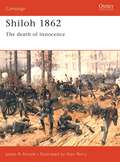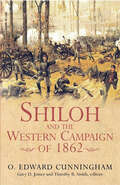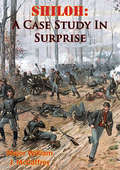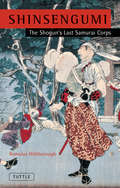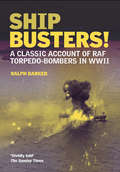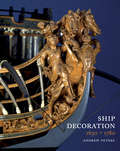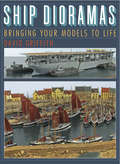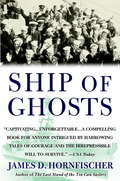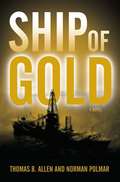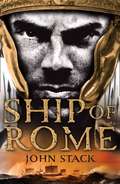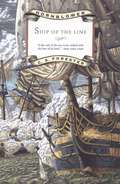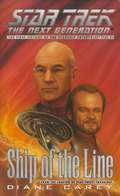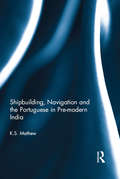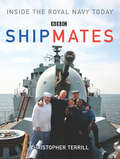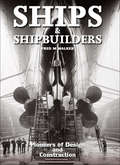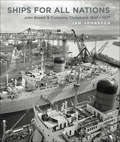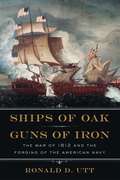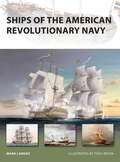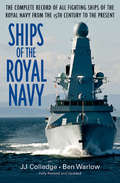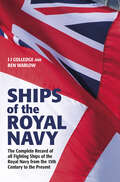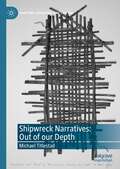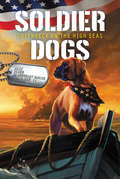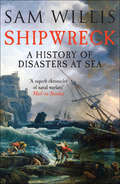- Table View
- List View
Shiloh 1862
by James Arnold Alan PerryThe first major battle in the Western theatre of the American Civil War (1861-1865), Shiloh came as a horrifying shock to both the American public and those in arms. For the first time they had some idea of the terrible price that would be paid for the preservation of the Union. On 6 April 1862 General Albert Sidney Johnston caught Grant and Sherman by surprise and very nearly drove them into the River Tennessee, but was mortally wounded in the process. Somehow Grant and Sherman hung on and the next day managed to drive back the hordes of grey-clad rebels.
Shiloh and the Western Campaign of 1862
by O. Edward Cunningham“May well be the best, most perceptive and authoritative account of the Battle of Shiloh.” —The Weekly StandardThe bloody and decisive two-day battle of Shiloh on April 6-7, 1862 changed the entire course of the American Civil War. The stunning Northern victory thrust Union commander Ulysses S. Grant into the national spotlight, claimed the life of Confederate commander Albert S. Johnston, and forever buried the notion that the Civil War would be a short conflict.The conflagration had its roots in the strong Union advance during the winter of 1861-1862 that resulted in the capture of Forts Henry and Donelson in Tennessee. The offensive collapsed General Johnston’s advanced line in Kentucky and forced him to withdraw all the way to northern Mississippi. Anxious to attack the enemy, Johnston began concentrating Southern forces at Corinth, a major railroad center just below the Tennessee border. His bold plan called for his Army of the Mississippi to march north and destroy General Grant’s Army of the Tennessee before it could link up with another Union army on the way to join him.On the morning of April 6, Johnston boasted to his subordinates, “Tonight we will water our horses in the Tennessee!” They nearly did so. Johnston’s sweeping attack hit the unsuspecting Federal camps at Pittsburg Landing and routed the enemy from position after position as they fell back toward the Tennessee River. Johnston’s death in the Peach Orchard, however, coupled with stubborn Federal resistance, widespread confusion, and Grant’s dogged determination to hold the field, saved the Union army from destruction. The arrival of General Don C. Buell’s reinforcements that night turned the tide of battle. The next day, Grant seized the initiative and attacked, driving the Confederates from the field. Shiloh was one of the bloodiest battles of the entire war, with nearly 24,000 killed, wounded, and missing.Edward Cunningham, a young Ph.D. candidate, researched and wrote Shiloh and the Western Campaign of 1862 in 1966. Though it remained unpublished, many Shiloh experts and park rangers consider it the best overall examination of the battle ever written. Indeed, Shiloh historiography is just now catching up with Cunningham, who was decades ahead of modern scholarship. Now, Western Civil War historians Gary Joiner and Timothy Smith have resurrected this beautifully written, deeply researched manuscript from undeserved obscurity. Fully edited and richly annotated with updated citations and observations, original maps, and a complete order of battle and table of losses, it represents battle history at its finest.
Shiloh: A Case Study In Surprise
by Major William J. McCaffreyThe commander must remain ever vigilant against surprise, for attacks born of the unexpected have the potential to alter quickly and irreversibly the relative combat power of opposing forces. A commander is better prepared to meet this threat when he is familiar with those factors which have contributed to surprise during past conflicts. This thesis investigates the surprise phenomenon through a case study of the battle at Shiloh Church.General Ulysses S. Grant, during the American Civil War, bivouacked his army near Shiloh Church on the Tennessee River's west bank while he awaited General Don Carlos Buell and the Army of the Ohio. On Buell's arrival the combined armies were to attack Corinth, Mississippi, where the Confederate forces under General Albert Sidney Johnston were known to be entrenched. Realizing the combined strength of the two Union armies would eventually prove overwhelming, Johnston decided to attack Grant's position before Buell could reinforce. He therefore attacked early Sunday morning, 6 April 1862. Apparently unaware that an attack was imminent, Grant had encamped his army with little regard for defense. The Confederates enjoyed success and forced the Union army against the Tennessee River. However, Buell reinforced Grant that evening, and on the following day the Union armies counterattacked and drove the Confederates back toward Corinth. Thus, the battle ended on a rather indecisive note.Among the more important conclusions of the thesis are:1. Although the Union forces below division level anticipated the Confederate attack. Grant and his command echelon were completely surprised.2. Surprise was achieved because the Union had violated several principles of war, chiefly: objective, offensive, maneuver, unity of command, and security.3. The Confederates were not without fault, for, had certain mistakes been avoided, their army might have won a total victory.
Shinsengumi: The Shogun's Last Samurai Corps
by Romulus HillsboroughShinsengumi: The Shogun's last Samurai Corps is the true story of the notorious samurai corps formed in 1863 to arrest or kill the enemies of the Tokugawa Shogun.<P><P>The only book in English about the Shinsengumi, it focuses on the corps' two charismatic leaders, Kondo Isami and Hijikata Toshizo, both impeccable swordsmen. It is a history-in-brief of the final years of the Bakufu, which collapsed in 1867 with the restoration of Imperial rule. In writing Shinsengumi, Hillsborough referred mostly to Japanese-language primary sources, including letters, memoirs, journals, interviews, and eyewitness accounts, as well as definitive biographies and histories of the era.The fall of the shogun's government (Tokugawa Bakufu, or simply Bakufu) in 1868, which had ruled Japan for over two and a half centuries, was the greatest event in modern Japanese history.The revolution, known as the Meiji Restoration, began with the violent reaction of samurai to the Bakufu's decision in 1854 to open the theretofore isolated country to "Western barbarians." Though opening the country was unavoidable, it was seen as a sign of weakness by the samurai who clamored to "expel the barbarians."Those samurai plotted to overthrow the shogun and restore the holy emperor to his ancient seat of power.
Ship Busters!: A Classic Account of RAF Torpedo-Bombers in WWII
by Ralph BarkerA &“vividly told&” history of torpedo attacks from the air in the Second World War, by a member of the Royal Air Force (The Sunday Times). Low-level strikes against enemy shipping by torpedo-carrying aircraft were perhaps the most dangerous forms of air attack developed during WWII, and few isolated actions had such a direct impact on naval and military actions. This book tells the story of the RAF men involved, from the early attacks by single Beauforts off the Dutch and Norwegian coasts to the massed assaults of later years by the famous &“strike-wings.&” The author, who joined the RAF in 1940 as a wireless operator/ air gunner, and served in the UK, the Middle East, and West Africa, and whose career on torpedo work ended in a crash in which his pilot and navigator were killed, includes many historic actions: the lone moonlight attack by a twenty-two-year-old flight sergeant on the pocket-battleship Lützow; the torpedoing of the Gneisena in Brest harbor; the Channel Dash of the Scharnhorst, Gneisena, and Prinz Eugen and the heroic Swordfish attacks; and the vital strikes from Malta in 1942 against the Italian fleet and the supply shipping of the Afrika Korps. The result is a fascinating book, vivid in its true picture of aircrew life, stirring in its descriptions of heroic actions, intensely moving in its record of human endeavor.
Ship Decoration, 1630–1780: 1630-1780
by Andrew PetersThis book is a detailed comparative study of the decorative work figurehead, topside ornamentation and stern gallery design carried by the ships of the major maritime states of Europe in the zenith of the sailing era. It covers both warships and the most prestigious merchant ships, the East Indiamen of the great chartered companies. The work began life in the year 2000 when the author was commissioned to carry out research for an ambitious project to build a full-size replica of a Swedish East Indiaman, which produced a corpus of information whose relevance stretched way beyond the immediate requirements of accurately decorating the replica.In tracking the artistic influences on European ship decoration, it became clear that this was essentially the story of the baroque style, its dissemination from France, and its gradual transformation into distinct national variations in Britain, the Netherlands, Denmark and Sweden. It is an inherently visual subject and the book illustrates developments with numerous photographs of contemporary ship models, paintings and plans, as well as the author's own interpretive illustrations of details.As the first major work on the topic for nearly a century, it will be of obvious appeal to ship modellers and historians, but with comparative examples drawn from architecture and sculpture, it also makes a broader contribution to the history of the applied arts.
Ship Dioramas: Bringing Your Models to Life
by David GriffithThe author of Ship Models from Kits &“has brought nautical scenes to life in his latest book&” (Daily Record). This book is about the art of displaying waterline models. By their very nature, ship models that do not show the full hull and are not mounted on an artificial stand cry out for a realistic setting. At its most basic this can be just a representation of the sea itself, but to give the model a context to tell some sort of story is far more challenging. In a diorama, the composition is a vital element and this book devotes much of its space to what works and what does not—and illustrates with photographic examples why the best maritime dioramas have visual power and how to achieve that impact. Individual chapters explore themes like having small craft in attendance on the main subject, multiple-model scenarios, dockyards and naval bases, and the difficulties of replicating naval combat realistically. It also looks at both extremes of modelmaking ambition: the small single-ship exposition and the largest, most ambitious projects of the kind meant for museum display. The book concludes with some of the most advanced concepts of how to create drama and the illusion of movement, and how to manipulate perspective. David Griffith&’s book is &“compelling and inspiring . . . littered with practical examples of work in progress, simple dioramas to the most complex . . . I highly recommend it to all ship modellers without hesitation&” (Scale Modelling Now).
Ship Spotter's Guide
by Angus KonstamShips have been part of military campaigns since the Ancient world, and this expertly illustrated and detailed Spotter's Guide offers a look at the 40 most iconic and recognizable ships throughout history. From the Viking longship through to the powerful modern aircraft carriers, and from the ironclads of the American Civil War to the awesome fighting ships of the Imperial Japanese Navy. Each ship is beautifully illustrated and is accompanied by a brief history. A perfect gift, this book is a must-have for any naval enthusiast and historian.
Ship of Ghosts: The Story of the USS Houston, FDR's Legendary Lost Cruiser, and the Epic Saga of her Survivors
by James D. HornfischerBONUS: This edition contains an excerpt from James D. Hornfischer's Neptune's Inferno. "Son, we're going to Hell." The navigator of the USS Houston confided these prophetic words to a young officer as he and his captain charted a course into U.S. naval legend. Renowned as FDR's favorite warship, the cruiser USS Houston was a prize target trapped in the far Pacific after Pearl Harbor. Without hope of reinforcement, her crew faced a superior Japanese force ruthlessly committed to total conquest. It wasn't a fair fight, but the men of the Houston would wage it to the death. Hornfischer brings to life the awesome terror of nighttime naval battles that turned decks into strobe-lit slaughterhouses, the deadly rain of fire from Japanese bombers, and the almost superhuman effort of the crew as they miraculously escaped disaster again and again-until their luck ran out during a daring action in Sunda Strait. There, hopelessly outnumbered, the Houston was finally sunk and its survivors taken prisoner. For more than three years their fate would be a mystery to families waiting at home. In the brutal privation of jungle POW camps dubiously immortalized in such films as The Bridge on the River Kwai, the war continued for the men of the Houston--a life-and-death struggle to survive forced labor, starvation, disease, and psychological torture. Here is the gritty, unvarnished story of the infamous Burma-Thailand Death Railway glamorized by Hollywood, but which in reality mercilessly reduced men to little more than animals, who fought back against their dehumanization with dignity, ingenuity, sabotage, will-power--and the undying faith that their country would prevail. Using journals and letters, rare historical documents, including testimony from postwar Japanese war crimes tribunals, and the eyewitness accounts of Houston's survivors, James Hornfischer has crafted an account of human valor so riveting and awe-inspiring, it's easy to forget that every single word is true.
Ship of Gold
by Thomas B. Allen Norman C. PolmarShip of Gold is an exciting, fast-paced tale of action, intrigue, and adventure on the high seas-told with the ringing authenticity only firsthand knowledge can impart.In 1945, the U.S. submarine Tigerfish mistakenly torpedoed and sunk a Japanese cargo ship. The ship, allegedly carrying supplies to allied POWs, had been given safe passage. But, in fact, the Osaka Maru was a Japanese Trojan horse: a cunning ruse devised by a powerful secret society to transport tons of gold out of Japan under the very eyes of the enemy. Some thirty years later, the commander of the Tigerfish is murdered in Washington. As the CIA launches its investigation into his death, a race to raise the ship and recover its treasure begins, which mounts to an international incident involving the U.S., China, the Soviet Union and Japan.The action of this taut thriller provides the behind-the-scenes reality of the national security system at work-the CIA, the Oval Office, the Pentagon, and the National Security Council-all scrambling to solve the crisis and to have control of the operation. It is a stunning portrait that all too closely resembles real life. This gripping, authentic thriller, which culminates in the most exciting naval chase since The Hunt for Red October, is must-reading for fans of Tom Clancy, Clive Cussler, and Alistair MacLean.
Ship of Rome (Masters of the Sea, Book #1)
by John StackAgainst a backdrop of the clash of the Roman and Carthaginian empires, the battle for sovereignty takes place on the high seas. Atticus, captain of one of the ships of Rome's small, coastal fleet, is from a Greek fishing family. Septimus, legionary commander, reluctantly ordered aboard ship, is from Rome, born into a traditionally army family. It could never be an easy alliance. But the arrival of a hostile fleet, larger, far more skilful and more powerful than any Atticus has encountered before, forces them to act together. So Atticus, one of Rome's few experienced sailors, finds himself propelled into the middle of a political struggle that is completely foreign to him. Rome need to build a navy fast but the obstacles are many; political animosities, legions adamant that they will only use their traditional methods; Roman prejudice even from friends, that all those not born in Rome are inferior citizens. The enemy are first class, experienced and determined to control the seas. Can Atticus, and the fledgling Roman navy, staffed with inexperienced sailors and unwilling legionaries, out-wit and out-fight his opponents. SHIP OF ROME, full of magnificent sea-battles, packed with strong characters, torn between two powerful empires, is the first book in a new series, MASTERS OF THE SEA, by a brilliant new author.
Ship of the Line (The Hornblower Saga, Book #2)
by C. S. ForesterMay 1810, seventeen years deep into the Napoleonic Wars. Captain Horatio Hornblower is newly in command of his first ship of the line, the seventy-four-gun HMS Sutherland, which he deems "the ugliest and least desirable two-decker in the Navy List." Moreover, she is 250 men short of a full crew, so Hornblower must enlist and train "poachers, bigamists, sheep-stealers," and other landlubbers. By the time the Sutherland reaches the blockaded Catalonian coast of Spain, the crew is capable of staging five astonishing solo raids against the French. But the grisly prospect of defeat and capture looms for both captain and crew as the Sutherland singlehandedly takes on four French ships.
Ship of the Line: Star Trek The Next Generation (Star Trek: The Next Generation)
by Diane CareyShip Of The Line tells the story of the first voyage of the U.S.S Enterprise NCC-1701-E, under the command of Morgan Bateson. Captain Bateson, a man from the 23rd century now living in the 24th, sees what no one else can see: that the Klingon Empire is building its forces and preparing to strike against the Federation. Seizing his one chance, Bateson takes the U.S.S. Enterprise on a mission to counter the Klingon threat, only to be thwarted by his enemy, a Klingon who has nursed a grudge against Bateson for decades. Standing in the way of Bateson's scheme and the Klingons' plan is Captain Jean-Luc Picard who, faced with the toughest decision of his career, must choose whether to take back command of the U.S.S Enterprise or let the torch pass to yet another next generation!
Shipbuilding, Navigation and the Portuguese in Pre-modern India
by K.S. MathewIndia, especially coastal India, has a long history of shipbuilding and navigation dating back to the Indus Valley Civilization. Indian shipwrights and the labour force associated with various aspects of shipbuilding excelled in naval architecture. Their native wisdom was adopted by the Europeans engaged in shipbuilding in coastal India. Similarly some of the techniques of navigation followed by Indians were emulated by the European mariners. A comprehensive peep into the science of naval architecture and navigation is attempted in this work making a comparative study of Indian and Portuguese architecture and navigation. The volume discusses the importance of the timber grown in the monsoon-fed forests of the Malabar coast and its appreciation by the Portuguese shipwrights and theoreticians of naval architecture. The work shows that increase of the tonnage of ocean-going vessels and the appearance of hostile mariners from other quarters of Western Europe compelled the Portuguese to adopt enhanced technology in naval architecture and navigation. The fact that the use of canons for defence against intruders made the Portuguese vessels stronger than the Indian ships which, for centuries, were accustomed to considerably peaceful navigation is also brought out in this much anticipated volume.
Shipmates
by Chris TerrillThis is the tie-in book to a two part BBC 1 documentary series to be screened at 9.00pm in October and which will end on the bicentenary of the Battle of Trafalgar on 21st October. Chris Terrill is famous for his fly on the wall documentaries which have been watched by millions and received wide critical acclaim. We have had HMS Brilliant and The Cruise (audience reached 11 million). Chris has based himself for the last few months in the very heart of the modern day naval experience. We will see: a Royal Naval Chaplain exorcising a haunted barracks in Portsmouth, a vodka-fuelled Trafalgar Day celebration in the British Embassy in the Moscow in 2004, a Polaris submarine crossing the Atlantic on an exercise in which it will 'pretend' to nuke America, the patrol of the frigate HMS Chatham in the Gulf, suddenly diverted to Sri Lanka after the Tsunami and the Fleet Review, where HMS Chatham in honour of her humanitarian role in Asia, will lead the entire assembly of a hundred warships, British and foreign, down the Solent. Chris is the only film maker to be granted exclusive, behind the scenes access by the Navy this year. During the filming Chris will capture the heart and soul of the sailors aboard, and on shore: there will be plenty of irreverence, practical jokes and laughs, and the human reality of the families left behind for months on end as warships and submarines go on extended tours of duty. This will be the fullest ever account of the Modern Navy in a year when the Trafalgar Day celebrations and the Fleet review will attract an avalanche of publicity.
Ships & Shipbuilders: Pioneers of Design and Construction
by Fred M. WalkerIn the past three centuries the ship has developed from the relatively unsophisticated sail-driven vessel which would have been familiar to the sailors of the Tudor navy, to the huge motor-driven container ships, nuclear submarines and vast cruise liners that ply our seas today. Who were the innovators and builders who, during that span of time, prompted and instigated the most significant advances?In the past three centuries the ship has developed from the relatively unsophisticated sail-driven vessel which would have been familiar to the sailors of the Tudor navy, to the huge motor-driven container ships, nuclear submarines and vast cruise liners that ply our seas today. Who were the innovators and builders who, during that span of time, prompted and instigated the most significant advances?In this new book the author describes the lives and deeds of more the 120 great engineers, scientists, philosophers, businessmen, shipwrights, naval architects and inventors who shaped ship design and shipbuilding world wide. Covering the story chronologically, and going back briefly even to Archimedes, such well-known names as Anthony Deane, Peter the Great, James Watt, Robert Fulton and Isambard Kingdom Brunel share space with lesser known characters like the luckless Frederic Sauvage, a pioneer of screw propulsion who, unable to interest the French navy in his tests in the early 1830s, was bankrupted and landed in debtors prison. With the inclusion of such names as Ben Lexcen, the Australian yacht designer who developed the controversial winged keel for the 1983 Americas Cup, the story is brought right up to date.Concise linking chapters place all these innovators in context so that a clear and fascinating history of the development of ships and shipbuilding emerges from the pages. An original and important new reference book.
Ships for All Nations: John Brown & Company Clydebank, 1847–1971
by Ian Johnston&“A worthy tribute to the John Brown company and to British shipbuilding . . . a joy to enthusiasts of the great ships of the past.&”—Australian Naval Institute The Clydebank shipyard built some of the most famous vessels in maritime history—great transatlantic liners like Lusitania, Queen Mary and QE2, and iconic warships like the battlecruiser Hood, and Britain&’s last battleship, HMS Vanguard. Starting life as J & G Thomson in 1847, the business acquired its more famous persona when taken over in 1899 by the Sheffield-based steelmaker John Brown & Co, which enhanced the yard&’s existing reputation for turning out first-class products, both naval and mercantile. This book charts the fortunes of the company in terms of its business development, its management and personnel, as well as the great variety of ships it built during the century and a quarter of its existence. It also tells a wider story of the rise to world domination of the British shipbuilding industry and its eventual decline and collapse in the post-war decades, as reflected in the experience of John Brown. Written by an acknowledged authority on Clydeside shipbuilding, the book was originally published in a limited edition in 2000, but this reprint is entirely new and revised, although it retains all the original photographs from the yard&’s own unrivaled collection. &“Essential to anyone&’s maritime collection.&”—Sea Breezes &“The profusely illustrated, beautifully produced and very detailed story of John Brown & Company.&”—Army Rumour Service
Ships of Oak, Guns of Iron: The War of 1812 and the Forging of the American Navy
by Ronald UttThe War of 1812 is typically noted for a handful of events: the burning of the White House, the rise of the Star Spangled Banner, and the battle of New Orleans. But in fact the greatest consequence of that distant conflict was the birth of the U.S. Navy. <P><P>During the War of 1812, America's tiny fleet took on the mightiest naval power on earth, besting the British in a string of victories that stunned both nations. <P><P>In his new book, Ships of Oak and Guns of Iron: The War of 1812 and the Birth of the American Navy, author Dr. Ronald Utt not only sheds new light on the naval battles of the War of 1812 and how they gave birth to our nation's great navy, but tells the story of the War of 1812 through the portraits of famous American war heroes. <P><P> From the cunning Stephen Decatur to the fierce David Porter, Ships of Oak and Guns of Iron relates how thousands of American men and boys gave better than they got against the British Navy. The great age of fighting sail is as rich in heroic drama as any epoch. <P><P>Dr. Utt's Ships of Oak and Guns of Iron retrieves the American chapter of that epoch from unjustified obscurity, and offers readers an intriguing chronicle of the War of 1812 as well as a unique perspective on the birth of the U.S. Navy.
Ships of the American Revolutionary Navy
by Mark LardasIn this title, Mark Lardas explores the origins of American warships, primarily light and medium frigates, built for the Continental Navy during the years 1776-1783. This was the first navy of the United States and much of the fleet was comprised of ships that had been modified from existing vessels, converted into warships to provide a crucial service during the American Revolutionary War. Despite having no real funding, this unique fleet had a surprising amount of success against the might of the Royal Navy, and this title discusses the strengths and weaknesses of each design, and the differences between European and American warships of the time. With a close look at how these ships performed in key battles, as well as the exploits of John Paul Jones - the founding father of the United States Navy - this is a complete, illustrated overview of the ships' service and development until France's entry into the war and the subsequent decline in importance of the Continental Navy.
Ships of the Royal Navy: The Complete Record of all Fighting Ships of the Royal Navy from the 15th Century to the Present
by J.J. Colledge Ben WarlowThe essential historical reference on British warships—fully revised. “Right at the top of the ‘must have’ list . . . A book which will get much use ” (Royal Navy and Maritime Book Reviews).This is the fourth fully revised edition of a book first published in 1970. This longevity is testimony to its enduring value as a reference work—indeed, “Colledge,” as the book is universally known, is still the first stop for anyone wanting more information on any British warship from the fifteenth century to the present day when only the name is known. Each entry gives concise details of dimensions, armament, and service dates, and its alphabetical and chronological arrangement makes it easy to track down the right ship—otherwise the Royal Navy’s tradition of reusing the same names can be misleading.When originally published, the second of the two volumes was devoted to minor fighting ships and hired and requisitioned vessels. For the third edition, published in one volume, this material was omitted, but for this edition, all the genuine fighting ships—like the numbered Coastal Forces craft—have been restored, resulting in a convenient but comprehensive single-volume listing of all significant vessels.Since the death of Jim Colledge, who was widely respected for his pioneering research on the technical details of warships, his magnum opus has been updated, corrected, and expanded with similar enthusiasm and attention to detail by Ben Warlow, a retired naval officer and author of a number of books in the field.“An amazing and immensely valuable work of dedicated and persistent research.” —Baird Maritime
Ships of the Royal Navy: The Complete Record of all Fighting Ships of the Royal Navy from the 15th Century to the Present
by Ben Warlow J J ColledgeNewly updated fifth edition: The remarkable reference that is “absolutely essential in every naval historian’s library” (Warship World).This is the latest updated edition of the book known simply as “Colledge” for its longtime reputation as the first stop for anyone wanting more information on any British warship from the fifteenth century to the present day when only the name is known. Each entry gives concise details of dimensions, armament, and service dates, and the volume’s alphabetical and chronological arrangement makes it easy to track down the right ship—avoiding the confusion and errors that can result due to the Royal Navy’s tradition of re-using the same names.This fifth edition contains some 200 new entries and revisions to many older entries. These reflect the demise of the post-Cold War ships as the Royal Navy was shrunk down as part of the peace dividend and successive defense reviews saw the loss of significant ships classes such as the Type 42 destroyers, Type 22 frigates, and the Illustrious class carriers. It is now being re-equipped in the face of new global challenges and has seen the introduction of the Queen Elizabeth class carriers, the largest ships ever built for the RN; the Type 45 destroyers; and Type 26 frigates and new patrol ships which will take on more global policing roles. Regarding submarines, the Cold War S and T classes are being replaced by the Astute class, and the deterrent role undertaken by the Vanguard class is to be carried forward by the Dreadnought class. Also included are the new RFAs, which are increasingly taking on frontline operations to release the small number of escorts to more combative roles. In addition, there are updates to the Royal Australian, Canadian, and New Zealand navies, which have programs to introduce new destroyers, Arctic patrol vessels, submarines, and support ships.Since the death of Jim Colledge, who was widely respected for his pioneering research on the technical details of warships, his magnum opus has been updated, corrected and expanded with similar enthusiasm and attention to detail by Ben Warlow, a retired naval officer and author of a number of books in the field.“An authoritative guide to British warships through the ages.” —Ships Monthly“The automatic starting point of research on Royal Navy ships.” —Lloyd’s List“[A] quite invaluable reference tool.” —The Mariner’s Mirror
Ships of the Royal Navy: The Complete Record of all Fighting Ships of the Royal Navy from the 15th Century to the Present
by Ben Warlow J J ColledgeNewly updated fifth edition: The remarkable reference that is “absolutely essential in every naval historian’s library” (Warship World).This is the latest updated edition of the book known simply as “Colledge” for its longtime reputation as the first stop for anyone wanting more information on any British warship from the fifteenth century to the present day when only the name is known. Each entry gives concise details of dimensions, armament, and service dates, and the volume’s alphabetical and chronological arrangement makes it easy to track down the right ship—avoiding the confusion and errors that can result due to the Royal Navy’s tradition of re-using the same names.This fifth edition contains some 200 new entries and revisions to many older entries. These reflect the demise of the post-Cold War ships as the Royal Navy was shrunk down as part of the peace dividend and successive defense reviews saw the loss of significant ships classes such as the Type 42 destroyers, Type 22 frigates, and the Illustrious class carriers. It is now being re-equipped in the face of new global challenges and has seen the introduction of the Queen Elizabeth class carriers, the largest ships ever built for the RN; the Type 45 destroyers; and Type 26 frigates and new patrol ships which will take on more global policing roles. Regarding submarines, the Cold War S and T classes are being replaced by the Astute class, and the deterrent role undertaken by the Vanguard class is to be carried forward by the Dreadnought class. Also included are the new RFAs, which are increasingly taking on frontline operations to release the small number of escorts to more combative roles. In addition, there are updates to the Royal Australian, Canadian, and New Zealand navies, which have programs to introduce new destroyers, Arctic patrol vessels, submarines, and support ships.Since the death of Jim Colledge, who was widely respected for his pioneering research on the technical details of warships, his magnum opus has been updated, corrected and expanded with similar enthusiasm and attention to detail by Ben Warlow, a retired naval officer and author of a number of books in the field.“An authoritative guide to British warships through the ages.” —Ships Monthly“The automatic starting point of research on Royal Navy ships.” —Lloyd’s List“[A] quite invaluable reference tool.” —The Mariner’s Mirror
Shipwreck Narratives: Out of our Depth (Maritime Literature and Culture)
by Michael TitlestadShipwreck Narratives: Out of Our Depth studies both the representation of shipwreck and the ways in which shipwrecks are used in creative, philosophical, and political works. The first part of the book examines historical shipwreck narratives published over a period of two centuries and their legacies. Michael Titlestad points to a range of narrative conventions, literary tropes and questions concerning representation and its limits in narratives about these historic shipwrecks. The second part engages novels, poems, films, artwork, and musical composition that grapple with shipwreck. Collectively the chapters suggest the spectacular productivity of shipwreck narrative; the multiple ways in which its concerns and logic have inspired anxious creativity in the last century. Titlestad recognizes in weaving in his personal experience that shipwreck—the destruction of form and the advent of disorder—could be seen not only as a corollary for his own neurological disorder, but also an abiding principle in tropology. This book describes how shipwreck has figured in texts (from historical narratives to fiction, film and music) as an analogue for emotional, psychological, and physical fragmentation.
Shipwreck on the High Seas (Soldier Dogs #7)
by Marcus SutterA World War II merchant marine ship is attacked by Nazi submarines in the seventh book in this action-packed middle grade series! Perfect for fans of the Hero and Scout books. A year after Pearl Harbor, cabin boy Julio and his loyal Boxer, Jack, join the US Merchant Marines on a dangerous mission to bring supplies to troops on the Pacific front.But when their convoy is attacked by German U-boats, their ship sinks, leaving Julio and Jack in a lifeboat fighting storms, sharks, starvation, and sickness. Can Julio and Jack help save the crew—and stay alive—as they search for land in the vast South Atlantic Ocean?
Shipwreck: A History of Disasters at Sea
by Sam WillisShipwrecks have captured our imagination for centuries. Here acclaimed historian Sam Willis traces the astonishing tales of ships that have met with disastrous ends, along with theensuing acts of courage, moments of sacrifice and episodes of villainy that inevitably occurred in the extreme conditions. Many were freak accidents, and their circumstances so extraordinary that they inspired literature--the ramming of the Essex by a sperm whale was immortalized in Herman Melville's Moby Dick. Some symbolize colossal human tragedy: including the legendary Titanic whose maiden voyage famously went from pleasure cruise to epic catastrophe. From the Kyrenia ship of 300 BC to the Mary Rose, through to the Kursk submarine tragedy of 2000, this is a thrilling work of narrative history from one of our most talented young historians.
